|
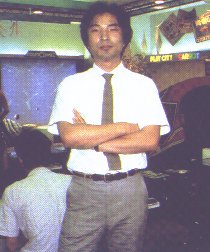
This
interview with the designer of Pac Man, Toru Iwatani,
comes from a book named "Programmers at Work" by Susan Lammers published in
1986. When I communicated with Susan recently she told me she is working on an updated version.
Game designer Toru Iwatani was born on January 25, 1955 in the
Meguro ward of Tokyo, Japan. He is totally self-taught, without
any formal training in computers, visual arts, or graphic design.
In 1977, at the age of 22, Iwatani joined NAMCO LIMITED, a computer
software company in Tokyo that produces video games. Once within
the company, Iwatani eventually found his place designing games.
He
completed Pac Man with the help of four others, after working
on it for a year and five months, taking it from concept to finished
product. The game was first introduced in Japan, where it was
very successful. When the games was exported, Pac Man captured
the imaginations of Americans and Europeans as well. Iwatani went
on to design more games, his favourite being Libble Rabble,
which he designed after finishing the Pac Man project. Lately,
Iwatani has become more involved in the administration of Namco
Limited.

Geoff Leach, a friend and associate in Tokyo, sent me a lively telex one day, saying he had learned the name of the designer of Pac Man through his boss, Mr.Imaizumi, who happened to he in a study group with the designer. He thought he might be able to arrange an interview for me. I fired back a telex, expressing my delight at the prospect.
In Japan, the individual responsible for creating or designing a product is often not singled out and recognised. The group or company receives the credit, and the individual, although known in certain circles, remains inaccessible and unidentified. In this case, due to the personal nature of the contact, the interview was granted.

Mr.
Leach and I took the subway to the outskirts of Tokyo to the offices
of Namco. After reaching our stop, we wandered down narrow, busy
streets in a shop-filled neighbourhood until we came upon a striking
brown marble building. The success of Pac Man had obviously served
the company well. We pushed through a set of double doors to enter
the large white-marble lobby, where we were immediately, welcomed
by a gesticulating lady robot receptionist. She was decorated
in pink and cream colours, with a nice pink helmet-like hat and
blue eyes, and she had a shapely feminine figure. There was not
another soul around. We paused, looking at her from a distance
behind the counter. As we moved further into the lobby, she motioned
us up to the counter. A computer terminal on the counter next
to her flashed "WELCOME TO NAMCO," and prompted is to look through
a telephone directory and call the person we wished to see.
We
stood at the counter quite amused and somewhat baffled by all
this, when the public relations director came up to greet us and
ushered us into a conference room where we were served tea while
we waited for Mr Iwatani to arrive. He entered the room and we
all stood and greeted, bowed, and exchanged business cards. Mr.
Iwatani was a tall, striking man with a quiet, yet forceful, manner.
He wore a light yellow polo shirt and wide-wale corduroy slacks.
It was explained that the interview would be conducted in Japanese,
with Mr. Leach acting as the interpreter. Iwatani spoke carefully
and thoughtfully in his deep voice, and as he expressed his thoughts,
he scribbled notes and sketches in his calendar notebook to illustrate
his points.
INTERVIWER: How did you first become interested in computers?
IWATANI:
I must tell you, I don't have any particular interest in them.
I'm interested in creating images that communicate with people.
A computer is not the only medium that uses images; I could use
the movies or television or any other visual medium. It just so
happens I use the computer. There's a limit to what you can do
with a computer Hardware limitations become my limitations. They
restrict me, and I'm no different from any artist - I don't like
constraints. I'm also limited because the only place the end result
appears is on the screen. Turn the computer off, and the images
vanish
INTERVIWER:
How did you choose video games as a way of communicating with
people?
IWATANI:
I entered this company, NAMCO, in 1977. I hadn't yet established
my own personal vision of what I would do here. My contribution
to the company just happened to take the form of video games.
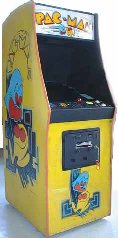
INTERVIEWER:
Had you ever studied game design or design in general?
IWATANI:
I had no special training at all; I am completely self-taught.
I don't fit the mold of a visual arts designer or a graphic designer
I just had a strong concept about what a game designer is - someone
who designs projects to make people happy. That's his purpose.
It's important for you to understand that I'm not a programmer.
I developed the specs and designed the features, but other people
who worked with me wrote the program.
INTERVIEWER: What was the thinking behind the design of Pac Man?
IWATANI:
First of all, the kanji word "taberu," to eat, came to mind. Game
design, you see, often begins with words. I started playing with
the word, making sketches in my notebook. All the computer games
available at the time were of the violent type - war games and
space invader types. There were no games that everyone could enjoy,
and especially none for women. I wanted to come up with a "comical"
game women could enjoy. The story I like to tell about the origin
of Pac Man is that one lunchtime I was quite hungry and I ordered
a whole pizza. I helped myself to a wedge and what was left was
the idea for the Pac Man shape.
INTERVIEWER:
Is that story about the pizza really true?
IWATANI:
Well, it's half true. In Japanese the character for mouth (kuchi)
is a square shape. It's not circular like the pizza, but I decided
to round it out. There was the temptation to make the Pac Man
shape less simple. While I was designing this game, someone suggested
we add eyes. But we eventually discarded that idea because once
we added eyes, we would want to add glasses and maybe a moustache.
There would just be no end to it. Food is the other part of the
basic concept. In my initial design I had put the player in the
midst of food all over the screen. As I thought about it. I realised
the player wouldn't know exactly what to do: the purpose of the
game would be obscure. So I created a maze and put the food in
it. Then whoever played the game would have some structure by
moving through the maze. The Japanese have a slang word - paku
paku - they use to describe the motion of the mouth opening and
closing while one eats. The name Pac Man came from that word.
INTERVIEWER: Once you decided Pac Man would be a game of food
and eating, what was the next step?
IWATANI:
Well, there's not much entertainment in a game of eating, so we
decided to create enemies to inject a little excitement and tension.
The player had to fight the enemies to get the food. And each
of the enemies has its own character. The enemies are four little
ghost-shaped monsters, each of them a different colour - blue,
yellow, pink and red. I used four different colours mostly to
please the women who play - I thought they would like the pretty
colours.

To
give the game some tension, I wanted the monsters to surround
Pac Man at some stage of the game. But I felt it would be too
stressful for a human being like Pac Man to be continually surrounded
and hunted down. So I created the monsters' invasions to come
in waves. They'd attack and then they'd retreat. As time went
by they would regroup, attack, and disperse again. It seemed more
natural than having constant attack. Then there was the design
of the spirit (kokoro), or the energy forces of Pac Man. If you've
played the game, you know that Pac Man had some ammunition of
his own. If he eats an energiser at one of the four corners of
the screen, he can retaliate by eating the enemy. This gives Pac
Man the opportunity to be the hunter as well as the hunted.

INTERVIEWER:
What did you intend the character of Pac Man to be like?
IWATANI:
Pac Man's character is difficult to explain even to the Japanese
- he is an innocent character. He hasn't been educated to discern
between good and evil. He acts more like a small child than a
grown-up person. Think of him as a child learning in the course
of his daily activities, If someone tells him guns are evil, he
would be the type to rush out and eat guns. But he would most
probably eat any gun, even the pistols of policemen who need them.
He's indiscriminate because he's naive. But he learns from experience
that some people, like policemen, should have pistols and that
he can't eat just any pistol in sight. (Iwatani begins sketching
diagrams of curves with points on his calendar notebook.)
INTERVIEWER:
What was the most difficult part of designing the game?
IWATANI:
The algorithm for the four ghosts who are dire enemies of the Pac
Man -getting all the movements lined up correctly. It was tricky
because the monster movements are quite complex. This is the heart
of the game. I wanted each ghostly enemy to have a specific character
and its own particular movements, so they weren't all just chasing
after Pac Man in single file, which would have been tiresome and
flat. One of them, the red one called Blinky, did chase directly
after Pac Man. The second ghost is positioned at a point a few
dots in front of Pac Man's mouth. That is his position. If Pac
Man is in the centre then Monster A and Monster B are equidistant
from him, but each moves independently almost "sandwiching" him.
The other ghosts move more at random. That way they get closer
to Pac Man in a natural way. When a human being is constantly
under attack like this, he becomes discouraged. So we developed
the wave-patterned attack-attack then disperse; as time goes by
the ghosts regroup and attack again. Gradually the peaks and valleys
in the curve of the wave become less pronounced so that the ghosts
attack more frequently.
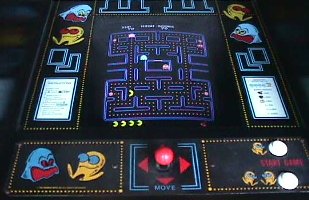
INTERVIEWER: Were there any other people working on the Pac Man
design team with you?
IWATANI:
There was one hardware engineer, one person who wrote the music,
and the package designer - approximately five people actually
worked on it, counting the programmer and me. From the concept
to the time the game was on the market was about one year and
five months - rather longer than usual. We tried out each feature
as we went along. If it wasn't fun or didn't add anything to the
game's complexity, we dropped it.
INTERVIEWER:
Was Pac Man as popular with women as you had expected him to be?
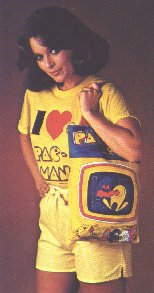
IWATANI:
Yes. Not only was Pac Man successful with women, but all the other
versions like Ms. Pac Man were successful, too. And Pac Man was
more popular in other parts of the world than I expected. I was
confident the game would sell reasonably well in Japan, but I
was quite surprised to see how well it sold in the United States
and other countries.
INTERWEWER:
Are there any aspects of Pac Man now wish that you could change?
IWATANI:
Pac Man was something I accomplished a long time ago. When I was
designing it, I felt I'd taken myself to the limits of my own
skill and what others were doing. I was satisfied then. But it
doesn't really have very much to do with who I am or what I am
doing today. There was another game I developed after Pac Man,
called Libble Rabble. The game concepts make it quite an interesting
game - even better than Pac Man. But it didn't do as well as I
expected.

INTERVIEWER: How has your life changed since you designed Pac
Man?
IWATANI:
My life hasn't changed in any big way; although my ideas about
what I want to achieve have. Recently I've felt I would like to
make the people who enjoy playing games cry - give them an emotion
different from the ones they're used to when they play video games.
I'd like to come up with some kind of very dramatic game. I want
them to have the opportunity to experience other emotions, like
sadness. They're not going to cry because they are hurt. They
will cry when they play my game for the same reasons people cry
when they see a movie like E.T., because it touches them. They
go to sad movies of their own free will because they like to be
moved, even though it's a sad feeling. I'd like to create a game
that would affect people that way.
INTERVIEWER:
Do you think it's more difficult to make people sad than it is
to make them happy?
IWATANI:
Much more difficult. It's possible to induce laughter in a short
time with jokes, but getting people to cry requires creating a
special situation, and that takes more time. A film such as E.T.
where one laughs and cries is quite difficult.

INTERVIEWER:
Do you ever tire of developing games?
IWATANI:
Right now. I'm getting away from the design process and am more
involved in administration. That's nice, because I can have my
staff do things I don't like to do very much and avoid the frustrations
I had before. Also I'm able to do the things I want to do - no
one tells me not to, and that's very comfortable.
INTERVIEWER:
Do you design other things besides games?
IWATANI:
One's actions are all designs, I feel. For example, if you are
seeing a woman, you think of ways to please her should you give
her a present? What kind of present? When should you give it to
her? You come up with some kind of strategy or game plan. Just
as in game design, you must derive pleasure from seeing the expression
of happiness on another's face. I belong to a study group of about
40 people, in which we talk about new media, including educational
software and the problems of education it can address. It's an
area we have to work on because it is an embarrassing fact that
the Japanese educational system is the worst. Frankly I think
that unless education is fun and entertaining, people won't learn.
My speciality, of course, is entertaining people. If there is
a learning objective that can be expressed in a fun way, it could
he the basis for a good game. I'm also interested in educational
software and computer-assisted instruction (CAI) for reasons of
economic survival. Companies concentrating only on game design
do not have a secure future. And there are many people with enough
interest to pay good money for educational software.
INTERVIEWER: What kind of skills or philosophy must a game designer
have to be successful?
IWATANI:
You must understand people's souls (kokoro) and be creative enough
to imagine things that can't be thought or imagined by others.
You must he compelled to do something a little bit different than
the rest of the crowd and enjoy being different. You must also
be able to visualise the images that will make up the game, and
you shouldn't compromise with the first easy idea that comes to
mind. In the last analysis, you must enjoy making people happy.
That's the basis of being a good game designer, and leads to great
game design.
INTERVIEWER:
Which game do you think is the best?
IWATANI:
Well, not to toot my own horn, but Libble Rabble is number one.
Among other companies' products though, Atari's games also seem
good.
INTERVIEWER:
What do you think game design will be like in ten years?
IWATANI:
It will be closer to the movies - that's happening even now as
we see the development of large-scale games. Also, there will
be an increase in multi-player, network games like Mega War -
the fascination of fighting the unknown. It's intriguing to think
of playing not only with another person, but with someone you
don't know and can't see.
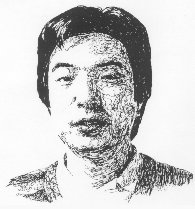
This document can
be found at the Retrogamer fanzine site: http://retrogamer.merseyworld.com/
To read a 1982 interview
with the head of Namco click here
I
have several Pac-man games for a wide variety of computers for
sale here.
The complete history of Pac-man can be read in Retrogamer 9 and the
story of all the other games in the Pac family in Retrogamer 11.
|

